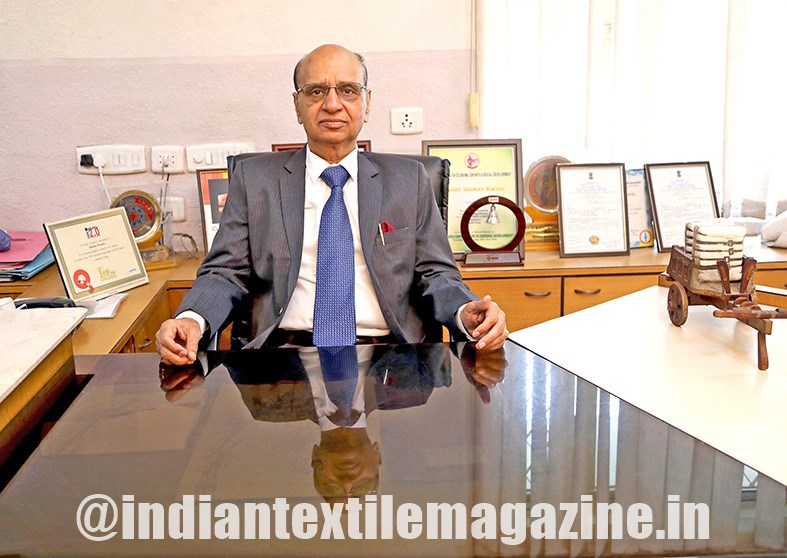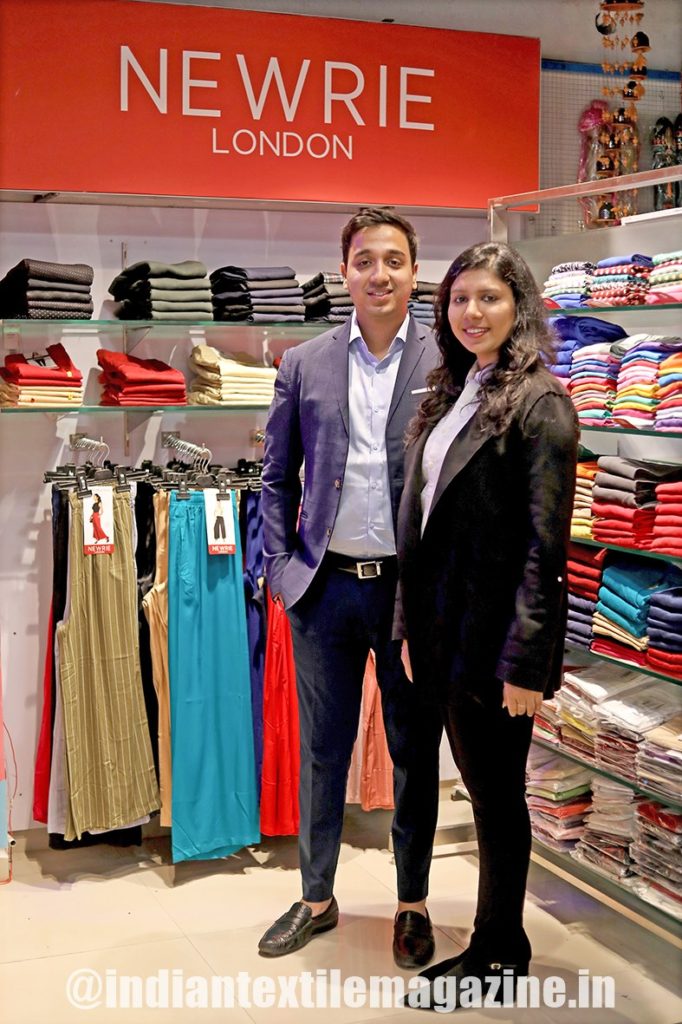With the second generation ushering in fresh thoughts and approaches to manufacturing, innovation and research and development, Salona Group is poised to achieve greater heights with not just new products but also a bigger global footprint
The Coimbatore region is known for its enterprising entrepreneurs, particularly in the field of textiles. Many a company has charted out its own distinct success story in this region. Salona Group is one such name, which has got a presence in spinning, knitting and fabrics and is now also making waves with its exclusive range of ladies’ apparel. What is heartening to note is the fact that the growth story of the group is being driven forward by the next generation entrepreneurial brother-sister duo of Raghav Agarwal and Saloni Agarwal. They work in tandem with their father, Manoj Jhajhariaa, himself a third generation entrepreneur, in driving forward the fortunes of the group.
Elaborating about his foray into the family business, Raghav Agarwal says: “I joined the business after my graduation in commerce. That was the time when we were looking to diversify from yarn and fabric to garments. We started off by making ladies’ leggings made out of cotton spandex, which was a hot seller product at that time. We realised that the easiest way to venture into this line was to sell something popular. The idea behind the diversification was that we were already supplying the raw material for these products to others. If they could make a finished product using our raw material and get good returns, it was obvious that we would be able to do so too. That was the trigger.”
“I joined the business in 2015 but took a break in 2016 and went to Westminster University in London to complete my Masters in International Business and Management. One of the motivations for joining the business was to travel and explore different cultures. I returned in 2017. By 2015 we had launched our own brand, Newrie. Now we have our own retail stores and trade partners. Along with leggings we now offer complete ladies’ bottom wear brands that includes jeggings, treggings, pencil pants, palazzos, etc. We also do a bit of tops too, for when people walk into a store, they expect to find a complete range. We are majorly into knits but have also ventured into the woven segment,” he adds.
The international exposure thus gained helped take the business to the next level. The company has of late been focusing on riding the e-commerce boom. “Our e-commerce presence is growing now. The ‘touch and feel’ concept is slowly dying now and people are willing to buy online. We have started promoting through digital and other media. We also have our own 15+ exclusive retail outlets, mostly in Delhi and the rest in South India,” he states. As for Saloni Agarwal’s foray into the business, she says: “I completed my post-graduation in software engineering in 2016. Being a lady entrepreneur helped me to understand the consumer base better and add insights to the product development.”
“I keep an eye on the current trends in the fashion industry. What are the new products being launched? What is the consumer demand? What does the future look like? That’s where I give my inputs. I also take care of the retail network and manage overall operations, including human resources. Being a software engineer I have tried to make the company digital-friendly. I have always been enthusiastic about this business. Even though I was studying engineering, I was very active in the entrepreneurs’ club. I always wanted to do something related to business,” she adds. Like her brother, Saloni Agarwal is also fond of travelling and exploring new trends and cultures and these are the inputs that provide fresh directions to the brand.

Clear Vision
Dwelling on the details regarding the vision that they have for the group, Raghav Agarwal says: “We were basically selling raw material, which is a commodity. But now we sell finished products and that makes a huge difference. We are aiming at forward integration, which is the ultimate goal of the company. We want to provide more employment to people through our manufacturing units, retail chain, distributors, etc. We believe in getting into the comfort zone of the customer and providing a good customer experience. Developing multiple brands under the Salona label and getting into the horizon where we can do justice to yarn, fabrics and garments under our logo is our goal.”
“We want to bring in the entire chain, maybe dyeing, finishing and stitching, in the near future. We want to become a knit composite unit,” he adds. Meanwhile, how has e-commerce help establish the brand name? Replies Saloni Agarwal: “With e-commerce, launching a brand has become easier. However, it is difficult to establish and sustain a brand that easily because accessibility has increased. There are products available across multiple price points. The textile industry, like many others, is highly competitive and therefore brand visibility assumes great significance. We have been working hard to establish the right image for the Salona brand and we are always open to experimenting with new ideas and trends.”
Transition Phase
So how does the earlier generation feel about the gradual transition of Salona from being a yarn and fabric company to a brand-focused one? “As a father it does feel good to see children taking the business forward. There is a lot of difference between the commodity market and a brand-focused approach. There it is more of a volume game. It deals more with pricing and how you penetrate the retail segment. Strategy-wise too there is quite a contrast. So far as branding in India is concerned, there is still a huge vacuum. There are not many domestically developed brands. Branding is also an expensive proposition because the retail rentals are high. This is where digital media and e-commerce become important,” says Manoj Jhajhariaa.
According to Raghav Agarwal, opportunities still exist in the group’s traditional yarn and fabrics division. “We participate in trade fairs around the world where we get to know what the customer wants and the market trends. We then develop blends, fabrics or finishes that we feel can add to the product basket. Given that, we plan to further promote our brand in the export market. I have been exposed to different verticals and trade partners in yarn, fabrics and garments, even in the international market. It has been a learning phase. The advantage we have over other companies is that where they start off with procurement of raw materials and then manufacture, being a composite unit it makes it easier for us to come up with new products.”
There have been challenges too. “One thing I have seen is that a lot of people, such as our trade partners, sales people, etc., always talk about how the textile industry is in a very bad shape. I have heard this over the past five odd years. I have never heard them say that this quarter or year has been good for the industry. Therefore, it is mentally challenging to keep your own self motivated amidst such talk. Secondly, being a family run company it was a challenge to get all our ideas in the same direction. Today we have a system wherein if we fix on one idea, we stick to it. Earlier it used to change frequently and that used to cause hurdles. We want to ensure that we are all on the same page and focused on the same end result,” Raghav Agarwal states.
The Roadmap
Summing up the future aspirations of the company, Manoj Jhajhariaa states: “Nowadays every five years or so you are witness to massive disruptions. This is not only at the machinery level but also by way of methodologies and mindsets. Today, salary is not as crucial to attract and retain good talent. Therefore, we also engage in providing opportunities to our staff to hone their skills further. We have in-house trainers and we also invite specialists. They are provided training not just related to their work but also for developing leadership skills, communication, etc. Moreover, we are focused on sustainability initiatives that include renewable energy like solar and wind power. We are also into recycling water and planting trees.”
Association with ITF
Manoj Jhajhariaa has been closely associated with the Indian Texpreneurs Federation right from its beginning. Going into details as to what makes ITF different from other associations, he opines: “The advantage with ITF is its flat hierarchy. There are no office-bearers. Only for the governing part we have a board of 32 Directors. We work on different verticals that include government policies, raw materials, yarn marketing, etc. A lot of information is shared so that our members find ways to grow. Our aim is the development of the textile industry.”
As for the role played by young members of the ITF, Raghav Agarwal says: “We have about 60 members as part of a new initiative that includes first, second and third generation entrepreneurs. We now have a platform for better interaction to create awareness about domestic and global trends, automation, new products and machines, etc.”
